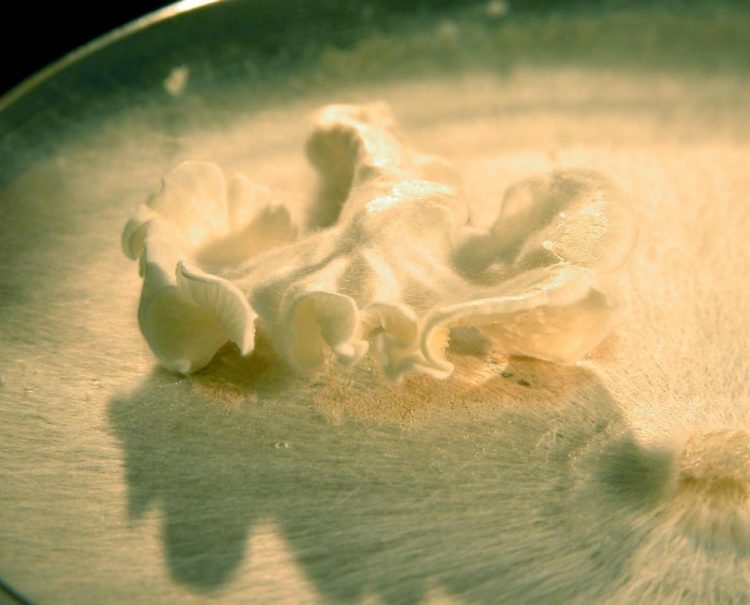Biology and chemistry combine to generate new antibiotics

Fruiting bodies from the mushroom Clitopilus passeckerianus generated in the laboratory. Credit: University of Bristol
With resistance growing to existing antibiotics, there is a vital and urgent need for the discovery and development of new antibiotics that are cost effective.
Promising developments are derivatives of the antibiotic pleuromutilin, with the core pleuromutilin isolated from the mushroom Clitopilus passeckerianus.
Pleuromutilin derivatives are potent antibacterial drugs but often require difficult chemical modifications.
In a new paper published today in Nature Communications, the Bristol team report the genetic characterisation of the steps involved in pleuromutilin biosynthesis through heterologous expression and generate a semi-synthetic pleuromutilin derivative with enhanced antibiotic activity.
This was achieved by taking the complete genetic pathway for pleuromutilin production, containing seven genes, from the mushroom, and rebuilding it in the industrially useful filamentous fungus Aspergillus oryzae, traditionally used to make soy sauce.
This then generated a unique platform of Aspergillus lines with combinations of the pathway genes to allow new compounds to be synthesized.
Professor Chris Willis, from the School of Chemistry, said: “This is a classic case where nature has produced something really useful, but combining nature with chemistry through a synthetic biology approach we are able to make things even better.”
These new compounds are some of the only new class of antibiotics to join the market recently as human therapeutics.
Furthermore, with their novel mode of action and lack of cross-resistance, pleuromutilins and their derivatives represent a class with further great potential, particularly for treating resistant strains such as methicillin-resistant Staphylococcus aureus (MRSA) and extensively drug resistant tuberculosis (XTB).
Professor Gary Foster from the School of Biological Sciences who led the team, with Dr Andy Bailey, added: “This research is very exciting as it also paves the way for future characterization of biosynthetic pathways of other basidiomycete natural products in ascomycete heterologous hosts.
“Many mushrooms have never even been examined and act as an untapped resource.
“The platform also opens up new possibilities of further chemical modification for the growing class of potent antibiotics.”
Media Contact
All latest news from the category: Life Sciences and Chemistry
Articles and reports from the Life Sciences and chemistry area deal with applied and basic research into modern biology, chemistry and human medicine.
Valuable information can be found on a range of life sciences fields including bacteriology, biochemistry, bionics, bioinformatics, biophysics, biotechnology, genetics, geobotany, human biology, marine biology, microbiology, molecular biology, cellular biology, zoology, bioinorganic chemistry, microchemistry and environmental chemistry.
Newest articles

NASA: Mystery of life’s handedness deepens
The mystery of why life uses molecules with specific orientations has deepened with a NASA-funded discovery that RNA — a key molecule thought to have potentially held the instructions for…

What are the effects of historic lithium mining on water quality?
Study reveals low levels of common contaminants but high levels of other elements in waters associated with an abandoned lithium mine. Lithium ore and mining waste from a historic lithium…

Quantum-inspired design boosts efficiency of heat-to-electricity conversion
Rice engineers take unconventional route to improving thermophotovoltaic systems. Researchers at Rice University have found a new way to improve a key element of thermophotovoltaic (TPV) systems, which convert heat…



